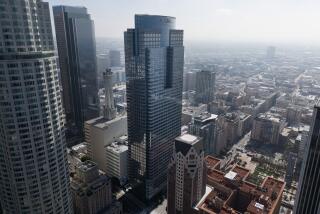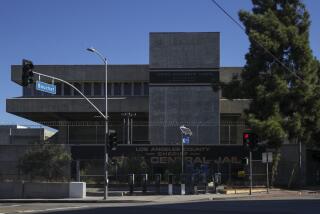Welding-Material Firm Jarred by Quake Lawsuit
- Share via
CLEVELAND — No one here could possibly have felt it, but the Northridge earthquake has arrived at a company in Cleveland.
The Lincoln Electric Co. has sold more welding metal than any other firm in the United States--including the type of material used to build many of the steel structures damaged by the January 1994 earthquake.
When the quake hit one of those structures, St. John’s Medical Plaza in Santa Monica, cracks tore clear through the building’s thick, welded connections of horizontal beams and vertical columns. Now, the doctors who own St. John’s are suing Lincoln Electric and others--contending that the weld metal Lincoln sold is a “defective product.”
It is a lawsuit with considerable implications for the company and for anyone who works or lives in a steel-frame structure, especially in the earthquake-prone West. For the first time the maker of the material that fuses the steel sections is accused of having marketed a product that will fracture prematurely.
Through its lawyers, Lincoln Electric has denied the allegations and vowed to vigorously defend against the lawsuit, which was filed without fanfare last May.
Lincoln’s product, known as “120” or “E70T-4,” has for two decades been the workhorse of weld metals used for steel buildings constructed in the West.
Steel fabricators liked E70T-4 because welders could apply it at up to 38 pounds per hour--about double the rate of other materials. This “high deposition” welding drastically lowered labor costs--a big consideration for building owners choosing between steel or concrete construction.
More Than $10 Million Sought in Suit
The owners of St. John’s are seeking more than $10 million. To prevail, they must establish that Lincoln should have known that E70T-4 was inadequate for welds in a seismically sensitive region, experts say.
“You would have to show that the manufacturer knew or had reason to know of the limitations, or dangers, of the product,” said Gary T. Schwartz, a professor at UCLA Law School.
The case is scheduled to go to trial in May in Los Angeles Superior Court. Representatives of Lincoln said factors other than the weld metal are responsible for the connections that fractured in scores of buildings during the Northridge quake.
A lawyer for the company, Richard G. Stuhan, said Lincoln and others relied on research conducted in the early 1970s at UC Berkeley, showing that E70T-4 performed adequately in the heavy beam-to-column, “moment-frame” connections that became standard in California construction.
Lincoln representatives said they were unable to identify which weld metal the company supplied for subsequent tests at Berkeley in the mid to late 1980s--when well over half of the connections failed at low stresses. The Berkeley engineer who led the research, Prof. Egor P. Popov, said he did not maintain a record of which weld metal was used.
Ideally, the weld metal is supposed to hold firm during a quake while horizontal beams bend slightly, without breaking.
Stuhan said he hopes to establish that the fractures at St. John’s started in the columns or the beams--not in the weld metal itself.
“What happened here wasn’t totally unexpected,” Stuhan said. “The building gave, but it was expected to give.”
Engineers at Lehigh University in Pennsylvania and at the University of Texas have confirmed in tests after the earthquake that E70T-4 fractures under stresses far lower than would be expected in a major earthquake. The material has one-fourth the resistance to fracture of other weld metals, including different products sold by Lincoln Electric.
“The frames were not supposed to crack up--they were supposed to bend and yield,” said George M. Soneff, a lawyer for St. John’s. “We believe the E70T-4 weld metal was the primary culprit. . . . It is a defective product.”
In Los Angeles, officials as of July 16, 1996, prohibited the use of E70T-4 and other, fracture-prone weld metals for major structural connections in new buildings. In June, Lincoln changed its product literature to advise customers that weld metals with higher fracture resistance “should be considered” for seismic applications.
Lincoln’s welding design engineer, Duane K. Miller, said the company’s change of its literature is not an admission that E-70T-4 was a faulty product.
“We’re embracing these requirements,” Miller said. “But does that imply that there was something inherently deficient? No.”
Other Damage Factors Cited
In recent interviews and in meetings with California authorities since the earthquake, Miller has cited factors other than the weld material as causing the damage to steel buildings: Deficient welding workmanship, the design details of the beam-to-column connections and lax inspection.
“When people were honing in on one issue, I kept trying to broaden the scope to bring in some of these other issues,” Miller said.
Despite the university research during the last 2 1/2 years, Miller said, he does not accept that the low fracture resistance of E70T-4 contributed to the Northridge damage. Unlike its competitors, Lincoln has provided materials and other support for the post-Northridge research.
As of today, Miller said, “There’s not sufficient evidence to suggest that [weld-metal] toughness was even a variable at all.”
Not in dispute is that St. John’s Medical Plaza was rocked hard by the January 1994 earthquake. Built in 1986, the five-story plaza provides office space and examination rooms for physicians, some of whom also practice next door at the older St. John’s Hospital.
The plaza building had no outward appearance of damage on the day of the earthquake and no one was hurt. But when inspection of began in late 1994, the dangers began emerging. According to engineering reports, cracks sheared completely through two of the structure’s major, supporting columns at six separate locations.
“The building’s ability to resist lateral forces [from an earthquake] has been compromised,” said a December 1994 report, prepared by Brandow & Johnston Associates, the engineering firm that designed the structure.
The report said that because of damage on the second floor, supports needed to be installed “to minimize the hazard of collapse, until permanent repairs can be performed.” The engineers determined that the building was unsafe and it was evacuated from April 1995 to October 1995.
The owners of St. John’s also are suing Brandow & Johnston, along with the general contractor, Dillingham Construction; the fabricator and erector, Riverside Steel; and the inspection firm, Smith-Emery Co. All of the defendants have denied St. John’s allegations of negligence and breach of contract. Some have filed suits against each other or St. John’s.
Soneff said he considers Lincoln chiefly responsible because the company marketed a product, E70T-4, for use in California’s steel-frame buildings despite its low fracture resistance.
Did Lincoln have reason to know that E70T-4 was inadequate for the uses to which it was being put? The sides disagree.
Concern About Use of E70T-4
Internal documents divulged by Lincoln in the litigation show that concern about the proper use of E70T-4 did arise soon after the earthquake. The company had sold E70T-4 to steel fabricators throughout the West as an easy-to-use material, conducive to high-production welding.
But when Miller, Lincoln’s welding-design engineer, searched for the company’s recommendations on how best to use the weld metal, he found the available information “poor or nonexistent,” according to an April 13, 1994 memo he wrote to a company executive.
“Careful review of our literature reveals lack of information or some inconsistencies on this issue,” Miller wrote to Paul F. Fantelli, vice president for business development.
Asked in an interview if this was an important oversight, Miller said the structural engineers who used E70T-4 could have gotten guidance from the American Welding Society’s code book. The code, however, does not address which types of weld metal are most appropriate for earthquake-prone areas.
“In the day of warning labels, I guess everybody can put on another one,” Miller said.
Stuhan, the company’s lawyer, said engineers could have chosen several other of Lincoln’s welding products that have much higher fracture resistance than E70T-4.
“Take GM: It manufactures Cadillacs, it manufactures Chevettes,” Stuhan said. “Can we say that a Chevette is defective because it doesn’t have the same crashworthy properties that a Cadillac does? I don’t think so.”
But wouldn’t an automobile maker want to install better brake-pad material if its vehicles were having trouble stopping?
“There are trade-offs that you have to make, and I think that’s true for welding material too,” Stuhan said, acknowledging that one trade-off of switching to material with more fracture resistance than E70T-4 would be the cost of a decline in high-volume production.
Use Burgeoned in the 1970s
Lincoln introduced the E70T-4 electrode under its own trade name in the 1960s and use of the product on the West Coast took off in the 1970s. Competitors have more recently made their own versions of E70T-4.
Founded in 1895, Lincoln last year reported that its total worldwide sales of welding metals, electric motors and other products topped $1 billion. Lincoln’s stock is now publicly traded on the NASDAQ exchange and the company has reported the St. John’s lawsuit in its public filings.
Lincoln Electric and two of the other parties being sued by St. John’s are asserting at least one common defense: The Northridge earthquake was a force beyond their control.
“An act of God,” said Glenn E. Turner III, a lawyer for Riverside Steel.
More to Read
Sign up for Essential California
The most important California stories and recommendations in your inbox every morning.
You may occasionally receive promotional content from the Los Angeles Times.











